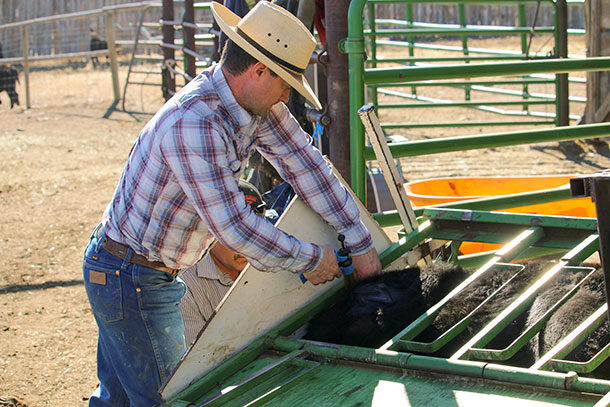With many producers’ cows safely calved and the youngsters looking shiny, a natural question arises – what will keep them healthy and growing through the remainder of the hot summer?
There is no “one-size-fits-all” plan, but it’s easier to send calves to pasture equipped with the necessary resources to fight against illness and strengthen their conditioning than to take shortcuts and hope for the best. Two remedies that fit together like pieces in a puzzle are vaccinations and creep feeding.
Install a well-designed vaccination program
Common thinking is fractured regarding vaccines. It is fact that for years they have benefitted both human and animal life, and as time marches on, new technologies and research are making vaccination programs even stronger.;
Vaccines might be considered an insurance or on-faith investment meant to pay off at weaning time and during the feedlot period. Bovine respiratory disease complex (BRDC) is the dangerous giant sporting a massive club at the weaning gate, ready to smite down any susceptible calves. It can be instigated by numerous stressors spread throughout the pre- and post-weaning processes. Events such as weaning, transportation or relocation, diet changes and commingling of different groups of cattle all conspire to trigger the disease.
Karl Hoppe, beef cattle nutritionist and extension livestock specialist for North Dakota State University, says respiratory disease is one of the primary risks to young calves, and anything done to enhance a calf’s immunity to specific potential pathogens helps decrease the risk of BRDC.
He says a modified-live vaccine (MLV), often called a 5-way viral vaccine, can provide excellent protection to nursing calves when administered according to label instructions.
Secondly, several pre- and post-weaning respiratory disease cases point the finger at earlier Mannheimia haemolytica infections. Vaccines aimed at this pathogen are often included in combination with MLV inoculations.
“It is important to remember many vaccines will require a booster shot to ensure adequate levels of protection,” says Hoppe. “Producers must be realistic and look closely at the operation’s capabilities when it comes to completing this task.” Are facilities and infrastructure available to round up the calf crop midsummer or is this challenge a non-starter? Without these boosters, a calf’s immune response will not be as aggressive, robust and long-lasting, but if the pathogen in question is limited, one dose may be enough.
Consider other preventative options
A standard vitamin injection and clostridial vaccination for blackleg strain diseases with or without tetanus is also vital. Clostridial bacteria is present in all soil conditions, and routine interaction between calves and the environment can cause spores to enter the gut and bloodstream with fatal results. The reasonably priced inoculation is well worth the cost. A second dose administered in the fall will raise immunity and provide further protection against this family of pathogens.
Internal and external parasites are also a major concern for cattle on grass. Afflicted calves will have reduced feed and/or forage intake, resulting in lower weaning weights. Internal parasites will also diminish the impact on the calf’s ability to respond to vaccination, so it’s critical to attack this potential problem early. External parasites such as horn or face flies should also be addressed depending on the severity of the problem.
Other basic health concerns calves will face include foot rot, pinkeye, bloat and pneumonias. Treatment drugs will need to be stocked to respond to these situations.
Assess the makings of a creep feeding program
A solid partnership to well-designed vaccination protocols and parasite controls can be a creep feeding system, but the goal must be decided if it is to be profitable and worthwhile for the producer, calves and cows. Is it meant to supplement grass in good environmental conditions; replace grass in poor-quality, late-in-season, drought-affected pasture; or aimed at weight gain and health-related matters?
An operation might complement the growing calf’s energy, trace mineral and salt requirements to help build stronger immune systems and better rumen function post-weaning. Or they may want the calf to become accustomed to eating from a bunk, which could decrease the stress of the weaning process.
Each reason ties back into the two original considerations of grass enhancement or replacement and can add value to a producer’s desired goals.
Hoppe recommends calves are started on creep as soon as possible to avoid digestive upsets, as it concerns him when pastures become overgrazed before it’s introduced. If this occurs, calves may overeat, resulting in sickness and even death. This potential risk makes it essential feeders are not allowed to run empty and present a temptation to gorge when filled.
Rations and ingredients are key. “If the pasture condition is good-to-exceptional, be sure to use a creep formulated to supplement grass, rather than replace it.” A nutritious, well-balanced free-choice feed should contain 14%-16% crude protein, be high in fiber and be fortified with vitamins and minerals, plus an ionophore to enhance efficiency, limit overeating and prevent coccidiosis.
He says producers should keep in mind they will need to offer more creep if using it as a replacement for pasture grass. For example, he estimates calves need as much as 8 to 9 pounds of creep for 1 pound of weight gain when used as a replacement for pasture grasses in comparison to only 5-7 pounds when supplementation is the goal.
“Producers must consider the desired result when deciding how much creep feed they will need,” says Hoppe. “Different factors will come into play. First-calf heifers and older cows won’t produce as much milk for their calves. And if the genetics of the calf crop are focused on growth traits, extra supplementation might be in order. Different factors will help with the decision of whether creep feeding is cost effective.”
The benefits of a structured vaccination program linked to a focused creep feeding system will vary from operation to operation. It should become routine practice, but to increase returns, it should enable fluid management decisions heavily dependent on environmental conditions and yearly price variations.









